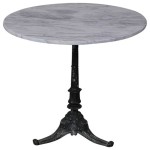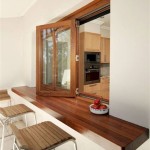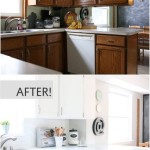How To Organize A Small Galley Kitchen With Island
The galley kitchen, characterized by two parallel countertops with a narrow walkway in between, presents unique organizational challenges. Adding an island to this layout, while potentially increasing workspace and storage, can further complicate the space if not planned and executed strategically. The goal of organizing a small galley kitchen with an island is to maximize efficiency, accessibility, and minimize clutter, creating a functional and aesthetically pleasing environment. This requires careful consideration of storage solutions, workflow optimization, and mindful decluttering practices.
Optimizing Storage Solutions in a Galley Kitchen with Island
Effective storage is paramount in any small kitchen, but it becomes even more critical in a galley kitchen with an island. The limited space necessitates the use of clever and space-saving storage solutions. Consider maximizing vertical space with tall cabinets that reach the ceiling. These cabinets can accommodate less frequently used items, freeing up space in lower cabinets for everyday essentials. Within these cabinets, utilize adjustable shelving to customize the space according to the sizes of your stored items. This prevents wasted space and allows for efficient organization.
In addition to tall cabinets, explore the use of under-cabinet lighting and organizers. Under-cabinet lighting illuminates the countertops and work surfaces, enhancing visibility and safety. Organizers such as spice racks, knife blocks, and utensil holders can be mounted under cabinets, freeing up valuable countertop space. These organizers keep frequently used items within easy reach while maintaining a clutter-free appearance.
The island itself presents a significant opportunity for additional storage. Consider incorporating drawers, cabinets, and open shelving into the island design. Drawers are ideal for storing utensils, cookware, and linens. Cabinets can house larger appliances, pots, and pans. Open shelving is perfect for displaying cookbooks, decorative items, or frequently used ingredients. The strategic placement of storage within the island can significantly improve the functionality and organization of the galley kitchen.
Another crucial element of optimizing storage is the implementation of internal organizers within cabinets and drawers. Drawer dividers can separate utensils, cutlery, and gadgets, preventing them from becoming jumbled and difficult to find. Cabinet organizers, such as pull-out shelves and lazy Susans, provide easy access to items stored in the back of cabinets. These organizers eliminate the need to reach deep into cabinets, reducing the risk of knocking over other items and improving overall efficiency.
Beyond traditional cabinets and drawers, explore unconventional storage solutions. Consider utilizing wall-mounted magnetic knife strips, pot racks, or pegboards to store frequently used items. These solutions not only free up cabinet and drawer space but also add a touch of visual interest to the kitchen. Hooks can be installed on the sides of cabinets or the island to hang measuring cups, utensils, or towels. These small details can make a significant difference in maximizing storage and minimizing clutter.
Furthermore, consider the weight capacity of shelves and drawers, especially when storing heavy items like cast iron cookware or stacks of plates. Reinforce shelving or opt for heavier-duty hardware to ensure the stability and longevity of the storage solutions. Distribute weight evenly across shelves and drawers to prevent sagging or damage. Regular maintenance and inspections can identify potential issues before they become significant problems.
Optimizing Workflow and Functionality in a Galley Kitchen with Island
A well-organized galley kitchen must prioritize workflow and functionality. The placement of appliances, the arrangement of work zones, and the ease of movement are all critical factors in creating an efficient and enjoyable cooking experience. The island, if positioned correctly, can significantly enhance workflow by providing additional counter space, a second sink, or a cooking zone.
The “work triangle” – the imaginary line connecting the sink, refrigerator, and stove – is a fundamental concept in kitchen design. In a galley kitchen with an island, the work triangle should be carefully considered to ensure efficient movement and minimize unnecessary steps. Ideally, the island should not obstruct the flow between these three critical work zones. If the island includes a sink or cooktop, it should be integrated into the work triangle to create a more functional and cohesive space.
Consider the placement of appliances in relation to the island. The refrigerator should be easily accessible from the island to allow for easy preparation of ingredients. The sink should be positioned near the dishwasher for efficient cleanup. The cooktop or range should be placed in a location that allows for easy monitoring of multiple dishes simultaneously. The goal is to create a workflow that minimizes unnecessary steps and maximizes efficiency.
The island can also serve as a multi-functional workspace. If space permits, consider incorporating a built-in cutting board or a drop-leaf extension to provide additional counter space when needed. The island can also be used as a casual dining area by adding bar stools. However, it is important to ensure that the island does not obstruct the flow of traffic through the galley kitchen. Maintain adequate clearance around the island to allow for comfortable movement.
Lighting plays a crucial role in kitchen functionality. Adequate lighting is essential for food preparation, cooking, and cleanup. Task lighting, such as under-cabinet lighting and pendant lights over the island, provides focused illumination for specific work areas. Ambient lighting, such as recessed lighting or a ceiling fixture, provides overall illumination for the kitchen. Natural light should also be maximized by ensuring that windows are not obstructed.
Furthermore, consider the placement of electrical outlets and other utilities. The island should have adequate electrical outlets to accommodate appliances, charging devices, and other electrical needs. Plan for the placement of these outlets carefully to avoid the need for extension cords or power strips. If the island includes a sink or cooktop, plumbing and gas lines will need to be installed. Consult with a qualified electrician and plumber to ensure that all utilities are installed safely and correctly.
Decluttering Practices for a Small Galley Kitchen with Island
Decluttering is an ongoing process that is essential for maintaining an organized and functional galley kitchen. Regularly assess the contents of your cabinets, drawers, and countertops, and remove any items that are no longer needed or used. The principle of “one in, one out” can be a helpful approach. For every new item that enters the kitchen, another item should be removed.
Start by identifying items that are duplicates, broken, or expired. These items should be discarded immediately. Next, identify items that are rarely used or not needed. Consider donating these items to charity or selling them online. Be honest with yourself about what you truly need and use. Resist the urge to hold onto items "just in case."
Store items near where they are used. For example, store pots and pans near the cooktop, and store baking supplies near the oven. This will make it easier to find items when you need them and will also help you identify items that are not being used. Group similar items together to create a more organized and efficient storage system. For example, store all measuring cups and spoons together, and store all spices together.
Maintain clear countertops. Countertops are valuable workspace, so they should be kept clear of clutter. Store small appliances, such as toasters and blenders, in cabinets or on shelves when they are not in use. Use countertop organizers to keep frequently used items, such as knives and utensils, within easy reach but organized. Avoid storing unnecessary items on the countertops, such as mail, papers, or decorative items.
Implement a regular cleaning schedule. A clean kitchen is an organized kitchen. Wipe down countertops and sinks daily to prevent buildup of dirt and grime. Sweep or mop the floor regularly to keep it clean. Clean out the refrigerator and pantry periodically to remove expired food. A clean kitchen is not only more pleasant to work in but also helps to prevent pests and foodborne illnesses.
Finally, consider incorporating decorative elements that also serve a functional purpose. For example, a beautiful fruit bowl can add a touch of color to the kitchen while also encouraging healthy eating habits. A stylish utensil holder can keep frequently used utensils organized and within easy reach. The key is to choose decorative items that are both aesthetically pleasing and functional, contributing to the overall organization and efficiency of the galley kitchen.

Beautiful Galley Kitchens How To Maximize Space And Style Decorcabinets Com

A Designer S 6 Top Tips For Your Galley Kitchen

Beautiful Galley Kitchens How To Maximize Space And Style Decorcabinets Com

10 Tips For Planning A Galley Kitchen

How To Remodel Galley Kitchen Maximize Space More

35 Galley Kitchen Ideas For Small Narrow And Wide Kitchens

Galley Kitchen Remodel Organization Reveal Organized Ish
:max_bytes(150000):strip_icc()/SouthernLiving_Glassburn-5-2000-5b67c8662f4c418aad74ea97b329b2df2-a1e43cf4746a477cbfda888d2a5ffe59.jpeg?strip=all)
What Is A Galley Kitchen And How To Make The Most Of It

35 Galley Kitchen Ideas For Small Narrow And Wide Kitchens

Galley Kitchen Remodel Organization Reveal Organized Ish
Related Posts








